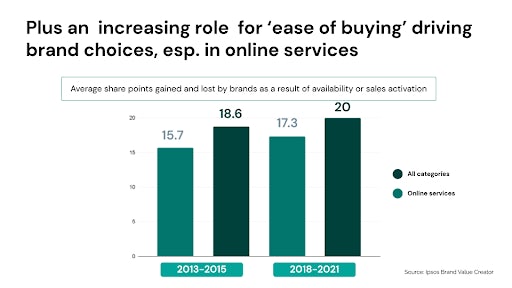Ignore the sceptics, brands can be built on digital platforms
Don’t delude yourself about returning to a ‘golden age’ of offline advertising. There’s plenty of evidence you can build successful brands with today’s media.
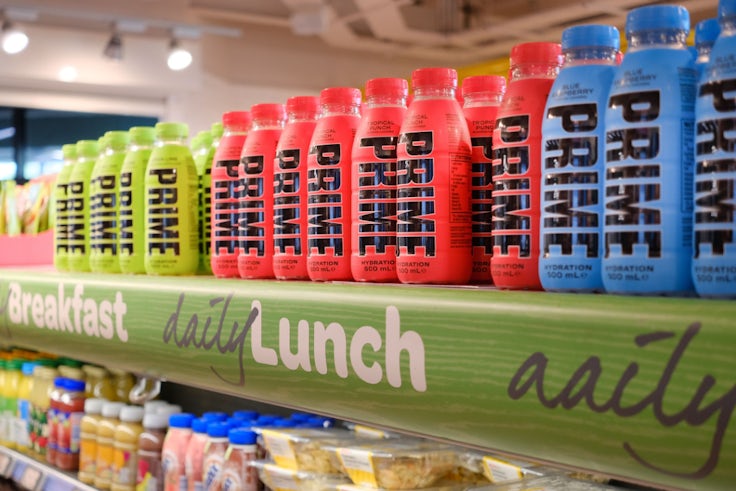
There are still people in adland who would love to turn back time to a pre-digital age. Who make bold claims like ‘digital can’t build brands’, or ‘no brand has ever been built solely with social media’.
Of course, no brand is ever built solely with advertising of any kind, it’s just one of many levers to be used in combination. And advertising is only ever a weak, not a strong force anyway. You don’t have to believe online advertising can build brands alone – just that it can make a meaningful contribution.
There’s also a less extreme feeling, a lingering doubt, that I think may be shared by a bigger chunk of adland, that the platforms dominating global advertising today aren’t yet, and perhaps never will be, as good as the previously dominant channels at helping build our brands.
Brand-building ads boost short-term sales, and now you can prove itBut beware golden ages, they’re always fantasies. Nostalgia’s an elephant trap for marketers – it won’t build our brands any more than neophilia will. We should prioritise the use of the tools that work today, not ones that worked much better yesterday or those that will only start working tomorrow.
Full disclosure. This is a personal perspective and one that’s bound to be influenced by what I’m learning in my role at Jellyfish, a platform-first marketing company that has just been acquired by the Brandtech Group, whose name alone signals a strong belief in brand building using digital platforms.
Before I come onto some of the evidence for brand building being perfectly and increasingly possible using the platforms we have today, I want to touch on ‘why now?’. Why are we at an inflection point where the technology is maturing and increasingly being used for brand building alongside its longstanding role assisting short-term sales?
Battle of the platforms
A fundamental factor is good old-fashioned market forces and the ongoing battle for market share of global ad spend by the platforms. Google and Meta built an unprecedented share of global advertising spend over the last two decades, initially from dominating companies’ lower-funnel budgets and by making direct response advertising vastly more accessible to millions of small companies than it had ever been before.
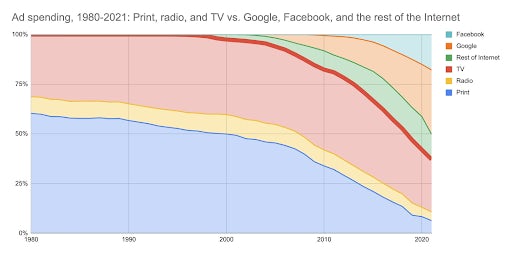
That level of growth could never continue, and they’re now being squeezed by both the social platforms and the huge growth of retail ad networks. So they’re now looking to both defend their existing massive shares of lower-funnel budgets and also grow their share of upper-funnel budgets. Everyone’s looking to match TikTok’s success in short-form video. They’re all increasingly pushing their platforms’ brand-building capabilities to grow their share of that piece of the pie.
The rise of video
The rise of the smartphone fuelled the explosion in digital video that’s enabling all this. Video now accounts for the vast majority of global internet traffic, around 80% by some estimates.
And where there’s video there’s brand building. Video is to brand building what water is to life on earth. More video content means more attention, more emotional impact, and sometimes a more personal and attentive viewing experience than on bigger, more public screens. All of which means more of the long-term brand memory encoding that’s needed to contribute to sales tomorrow, not just sales today. AKA brand building.
Google’s main weapon against TV is naturally YouTube. SmartTVs come with it built-in so more YouTube content is being watched on the main large screen in a household than ever (33% of YouTube viewing in the UK happens on TVs, according to BARB, and 45% in the US, according to YouTube data).
YouTube videos are being made with ever-higher production values, so it’s great content to put ads in and around. It’s probably the most powerful of the digital platforms for brand-building still, given the number of seconds of attention its ads command. But TikTok’s closing in, and is also helping to accelerate the growth in the video-creator economy.
The rise of the digital platforms inspired an intellectual fightback by the established marketing world in defence of what works to build brands over the long term.
Meta is playing catch-up when it comes to video, with video still responsible for only around 15% of all content viewed on Facebook. I suspect the proportion of time spent on a given platform watching video content is probably a crude measure of its potential as a brand-building channel.
In the case of Google, innovation is making its traditional search business more upper funnel friendly. Google’s new Performance Max product generates AI-assisted video and other brand assets that are more polished and consistent with a brand’s visual identity and tone of voice than ever. Improvements in the impact of brand-building advertising can happen through better integration through the funnel, not just by creating more impact at the top.
And, just as the first platforms made direct-response advertising more accessible to millions of small businesses, some of the tools of brand-building advertising are now increasingly available to businesses of all sizes. My 14-year-old son spends his Saturday afternoons making TikToks for the local trainer store, which regularly get hundreds of thousands of views and occasionally millions. These have quickly gained 18,000 followers, 48% of whom are local, which must include most of the sneakerheads in the area. A role for video previously completely off limits to a tiny, and never busier, local store.
A brand-building counter-revolution
All this is being underpinned by a greater understanding than ever of how brand-building really works. I don’t think it’s a coincidence that several of the most important books on brand growth (including Binet & Field’s seminal ‘The Long and the Short of It’) were published during advertising’s digital revolution. I suspect the rise of the digital platforms inspired an intellectual fightback by the established marketing world in defence of what works to build brands over the long term, against a new world that was putting short-term digital tactics first.
Changes to privacy laws and Apple’s subsequent updates to its operating system are also leading to a renewed interest in brand building.
Privacy regulations are affecting the ability of adtech to capture data on users and use cookies to track them across the internet and apps. Some of the links in the chain that allowed a clear sight of the ads an individual is served and the things they buy are now broken. This has made brand advertising, which rarely demands that level of granular understanding of its impact on an individual, relatively more attractive than previously, including to businesses who wouldn’t have considered doing something so ‘unaccountable’ before.
This is leading to the digital measurement world looking less to attribution and more to measurement techniques such as econometrics and geo-experiments – both better able to capture the impact of brand activity.
The performance plateau
Increasing numbers of brands, having once had a more performance-driven approach, are also getting to a point where their lower-funnel activity reaches saturation, they reach a performance plateau, and they then try a more balanced full-funnel strategy. I’ve written about this previously so won’t go over that here – but the sheer number of brands experiencing this feels like it must be a factor in why more and more brands are turning to digital for brand building, not just performance.
Econometrician Grace Kite and the Advertising Research Community (ARC) produce meta-analyses of the econometric modelling of the impact of media on everyday brands and campaigns, not just effectiveness awards winners (which are the basis of Binet and Field’s research). This work has been helpful in understanding the optimum balance between online and offline ad spend. ARC’s conclusion in 2021 was that on average the optimum percentage to spend online was 40% to 50%.
Marketers on the recipe for success when building brands onlineARC has also been shedding light on the ‘crisis in ad effectiveness’ that coincided with the initial growth of digital advertising, in which short-termism the obvious culprit, and which now appears to be coming to an end.
Various recent studies, including by ARC, have shown how many of the digital channels are equally capable of producing both short- and long-term effects, vital evidence to help end the view that digital advertising is just for triggering an immediate response.
According to econometrics company Analytics Partners, most digital channels are capable of contributing to the long as well as the short term. The importance of video for brand-building is also evident in their analysis, the lasting impact of video channels typically being twice as long as non-video channels.
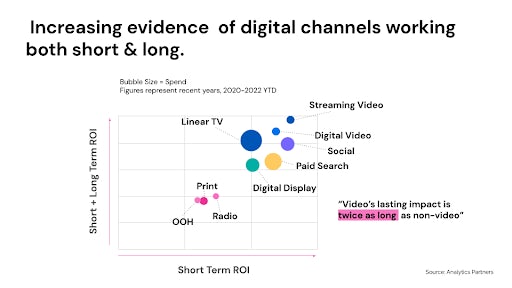
Brands built in digital
So what brands can we point to that have been built partly or solely using today’s platforms?
Prime, the sports drink set up by YouTubers Logan Paul and KSI as a challenger to Gatorade, is always pretty high up the list when you ask people this question. It’s a smart mix of celebrity influencer endorsement, a cleverly formulated product, promotional content featuring its two celebrity founders across a range of social channels, and sponsorship of UFC and Arsenal. It has also managed to get pretty mainstream distribution via Asda. Scarcity has played a big role in driving its success in the UK, and it will certainly be interesting to see what happens once the hype has abated.
All this has made it playground currency for today’s kids, as valuable as anything the legendary 1990s agency HHCL achieved with its ‘You’ve been Tango’d’ campaigns of 30 years ago. Is the marketing as good? If it can be sustained, yes. Are the ads as good? Probably not if judged purely as ‘ads’. Is Prime being built solely in social? No, it’s built, like all brands, with an array of different tools and tactics across all of marketing’s Ps, but it’s certainly ‘social-first’.
All of which suggests brand building is absolutely possible in today’s platforms, and that many brands are achieving it already.
Similarly, Gymshark achieved profitability and unicorn status in a decade, and got there partly by growing a cult-like following in social media fuelled by influencer marketing. You have to be wary of placing too much emphasis on individual case studies, but this is a brand being ‘built in social’ with considerable creativity and marketing nous.
If we need more examples, there’s a fascinating and highly successful cohort of global SaaS brands such as Fiverr, Monday and Wix, which are often big YouTube advertisers, many of which continue to see success despite the current downturn in the tech market.
Are there bigger, more valuable brands and businesses out there that are less reliant on social or digital advertising? Yes. But it’s hard to imagine any of the world’s biggest brands not seeing digital advertising as an important part of their brand-building mix today, as well as of their sales-activation mix.
Continued importance of brand equity
A discussion with Ipsos on the topic of ‘brand building in digital’ led to this question: given the massive shift in ad spend towards digital channels, if digital advertising were only about driving short-term sales, shouldn’t we have seen a big downward shift in the importance of brand equity as a driver of purchase decisions?
Well no, as it turns out. There’s actually been no decline in the importance of brand equity in the purchase decisions people make according to Ipsos’ ‘Brand Value Creator’, which suggests that “strength in the mind remains as important as ever as a driver of purchase decisions” – staying at the same level across its entire global database over the 2018-21 period as during 2013-15.
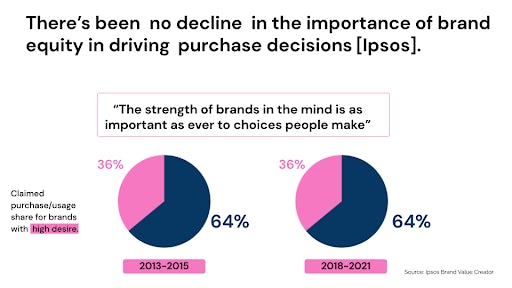 Ipsos data also suggests that ‘ease of buying’ as a factor in purchase decisions has grown over the same period, especially in online services categories, suggesting that whilst brands are still being built in the digital age, digital channels may also be creating greater opportunities to close the sale. Digital has been additive for marketing, not subtractive.
Ipsos data also suggests that ‘ease of buying’ as a factor in purchase decisions has grown over the same period, especially in online services categories, suggesting that whilst brands are still being built in the digital age, digital channels may also be creating greater opportunities to close the sale. Digital has been additive for marketing, not subtractive.
What marketers think
But what about the clients’ view of all this? What do marketers believe about brand-building in digital? Do they think digital has a lot of ground to catch up before it’s seen to be as useful as ‘traditional’ channels for brand building?
Actually Marketing Week’s latest ‘Language of Effectiveness’ survey of over 1,300 marketers suggests digital is far more mature for brand-building than others may believe. In fact a huge number, 86.7%, believe digital media is effective at brand-building, which is more than the 80.1% who believe offline media is effective at building brands.
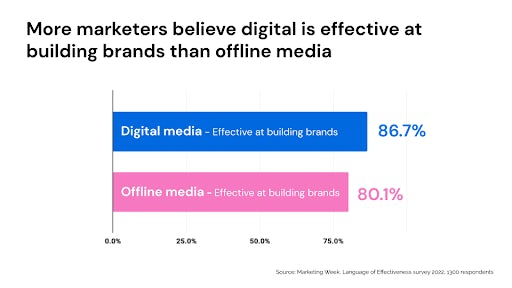 So marketers are far more optimistic than any of the adland sceptics, and their perspective is much more in line with the econometrics data.
So marketers are far more optimistic than any of the adland sceptics, and their perspective is much more in line with the econometrics data.
All of which suggests brand building is absolutely possible in today’s platforms, and that many brands are achieving it already.
The nostalgics may have had a point – maybe we just weren’t very good at using digital to build brands initially. But over time we’re learning how to use the new tools and are getting better at it.
But could we get even better? Almost certainly, especially when it comes to creativity. And we’ll look at that more closely in part two.
